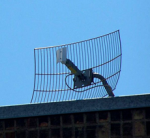Microwave bands
 Operating on the microwave bands represents a greater challenge than lower frequencies, but can be a source of real achievement. The available bandwidth and high antenna gains make them home to a wide variety of modes including narrowband, FM, EME, data links, ATV and Satellites.
Operating on the microwave bands represents a greater challenge than lower frequencies, but can be a source of real achievement. The available bandwidth and high antenna gains make them home to a wide variety of modes including narrowband, FM, EME, data links, ATV and Satellites.
Calling CQ on the microwave bands can be pretty futile as the probability of your antenna and the other stations antenna being aligned falls significantly. Likewise modern stations need good frequency accuracy so as not to miss each other. The following give some pointers to microwave operating:-
Antenna Gain & Pointing
A key feature of microwaves is that the higher antenna gains can give considerable distance but do have narrower beamwidths. Therefore being able to repeatably point the antenna in a known direction becomes important. For example, on 23cms with a beamwidth of 20 degrees (an eighteenth of a circle), the probability of two stations having coincident antenna beams is one in 18*18 , or 1: 324. The typical beam width of a 10GHz dish (similar to a Satellite TV dish) gives a probability closer to 1: 32400. Even with some form of talkback, making sure the initial beam heading is accurate can mean the difference between a contact being made and nothing being heard. It is thus increasingly important at higher frequencies to calibrate your antenna direction to a known station or beacon. For EME stations, this of course means that mounts and rotators also have to follow the moon accurately.
Frequency Control
Frequency accuracy and stability are key issues at microwave frequencies, particualry for narrowband operating. Some transverters have crystal heaters to try to improve thermal stability, but crystal ageing and alignment can still lead to errors at the final frequency. More modern synthesised radios and transverters usually have a reference OCXO to improve frequency stability. Further improvements have been gained by locking reference oscillators to GPS signals.
Whatever form of local oscillator or reference you use, it is a very good idea to check the frequency of a local beacon or a station with a GPS locked source and note any frequency difference. When arranging a QSO via talkback it is vital that both stations use the same frequency give or take the bandwidth of the receiver otherwise you may not hear each other.
Talkback
Some form of talkback is essential for all but local contacts. The original method was to use the 2m band, and this is still used by some stations on or around 144.175MHz. This can be problematic if there is local QRN/QRM, or if you have the case where your microwave DX distance exceeds your capability/propagation on 2m – and that is possible! Portable operators may therefore need to take a fairly capable 2m system.
Many stations now use the ON4KST website for sending messages to other stations. This is based on an internet connection, which can itself be a challenge when out portable. The key issue here is that QSO information needs to be exchanged over the air and not passed over KST. This newer talkback method can be a contentious issue with those who prefer 2m talkback. In practice many portables usually try to take both 2m and KST with them.
Beacons
Beacons are a vital resource on the microwave bands, providing frequency references, direction references and propagation indicators. In addtion to standard reference information, a useful resource is the Beaconspot website which extracts beacon reports from the DX cluster and maps their reception distances.
Operating Tips
Listening
- Listen to Beacons
- Understand the propagtion conditions
- Listen before you call CQ
- At the end of the QSO always listen for other stations calling
- Listen in activity evenings or contests when there is more activity on the bands
Transmitting
- Before calling CQ check that the frequency is not occupied
- A random CQ call is only good for attracting the attention of local stations, unless you are very lucky
- When finishing a QSO always announce a frequency you will QSY to – and go and listen there – remember others will be watching KST to see who you were working and where you were beaming
- If you turn your antenna you may find it already in use – if it is then move










